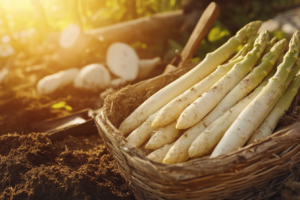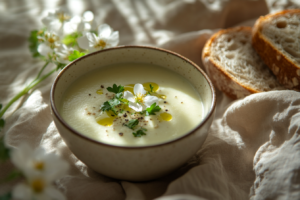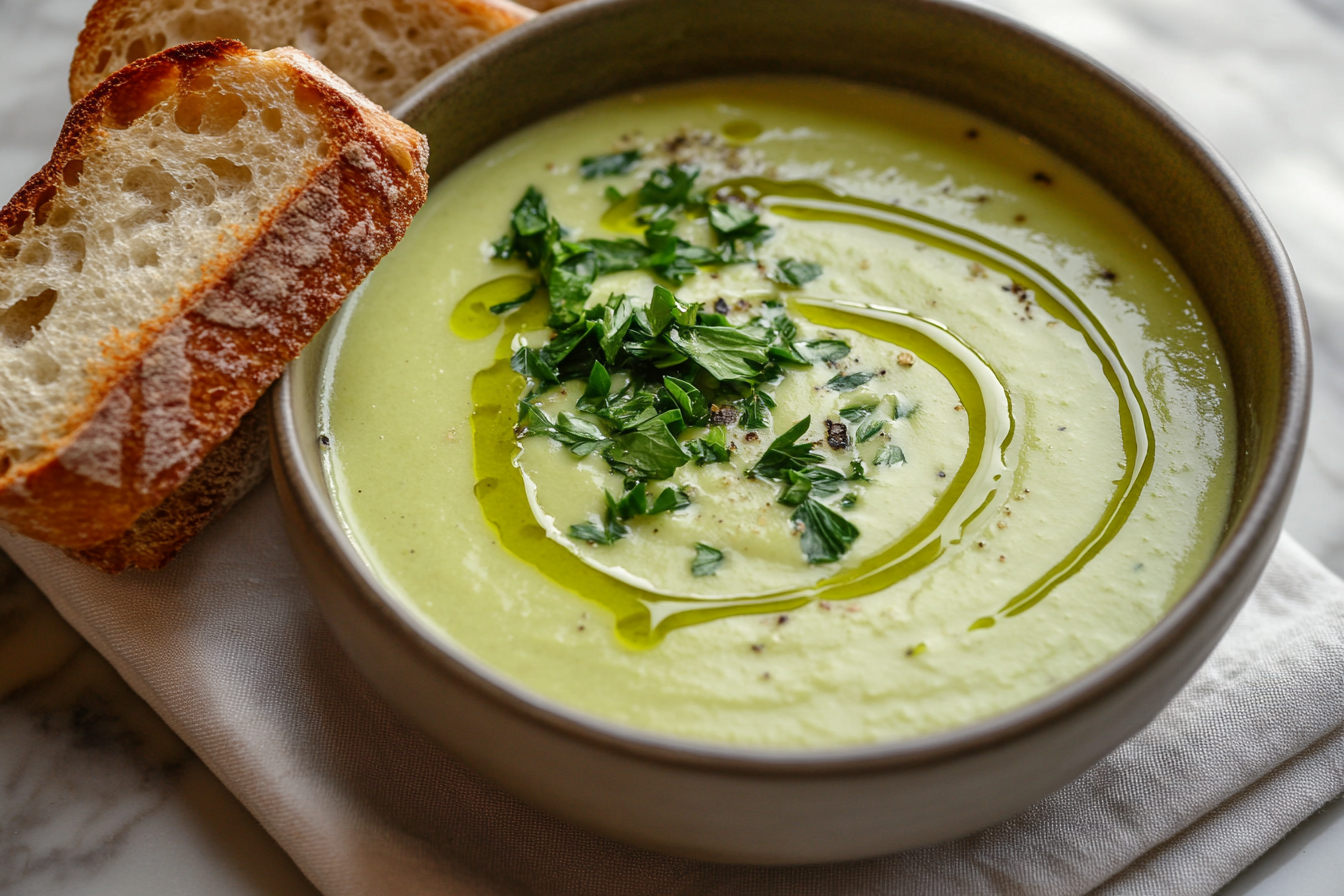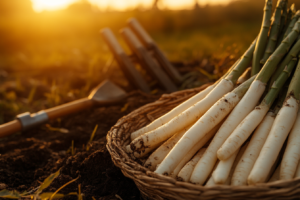Asparagus, or Spargel as the Germans call it, isn’t just a vegetable in Germany—it’s a culinary treasure! From soups and salads to hearty meals, asparagus plays a starring role in many traditional recipes. Whether it’s the tender white asparagus prized during Spargelzeit or the more common green variety, these dishes showcase the love Germans have for this versatile ingredient. Let’s dive into the delicious world of asparagus German recipes, starting with the roots of its cultural significance.
Introduction to Asparagus in German Cuisine
The Significance of Asparagus in Germany
When spring arrives, so does Spargelzeit—Germany’s beloved asparagus season. But what’s so special about asparagus here? Well, for one, it’s a symbol of freshness, luxury, and culinary heritage. Germans take asparagus seriously, often referring to it as the “king of vegetables.”
Historically, asparagus has been cultivated in Germany since the 16th century. It was once a delicacy reserved for royalty and the wealthy. Over the years, it became more accessible, turning into a national obsession during harvest time. Today, farmers’ markets overflow with fresh stalks, and restaurants create special menus dedicated to this seasonal star.
White vs. Green Asparagus: A German Preference
While both white and green asparagus are grown in Germany, there’s no contest—white asparagus reigns supreme. Why? Its milder flavor and tender texture appeal to the German palate, making it perfect for traditional recipes.
White asparagus, grown underground to prevent chlorophyll from developing, is considered a delicacy. On the other hand, green asparagus, though more common in international cuisine, is rarely the centerpiece of German meals.
In fact, white asparagus is so celebrated that there are even asparagus festivals in regions like Baden-Württemberg and Lower Saxony! These events highlight not only the vegetable but also its cultural and economic significance.
Pro Tip: If you’re planning to try white asparagus recipes at home, make sure to peel the stalks thoroughly to remove the fibrous outer layer.
Traditional German Asparagus Recipes
Germany’s love for asparagus, particularly the tender white variety, is evident in its wide array of classic recipes. From creamy soups to hearty salads, these dishes highlight asparagus’s versatility and flavor. Let’s dive into some of the most beloved asparagus German recipes that are sure to delight your taste buds.
White Asparagus with Hollandaise Sauce (Spargel mit Sauce Hollandaise)
Ingredients and Preparation Steps

This quintessential German dish combines the mild taste of white asparagus with the richness of Hollandaise sauce, creating an elegant yet simple meal.
Ingredients:
- 1 kg white asparagus, peeled
- 1 tbsp sugar
- 1 tsp salt
- 150 g butter
- 2 egg yolks
- 1 tbsp lemon juice
- A pinch of cayenne pepper
Preparation Steps:
- Boil a large pot of water with sugar and salt.
- Add the peeled white asparagus and cook for 8–10 minutes or until tender.
- While the asparagus cooks, melt butter over low heat.
- In a bowl, whisk egg yolks with lemon juice and cayenne pepper. Slowly add the melted butter, whisking continuously to create the Hollandaise sauce.
Serving Suggestions
Serve the asparagus warm, drizzled generously with Hollandaise sauce. Pair it with boiled potatoes and a side of crusty bread for a complete meal.
Asparagus Cream Soup (Spargelsuppe)
Ingredients and Preparation Steps

This velvety soup is a staple in German kitchens, especially during Spargelzeit.
Ingredients:
- 500 g white asparagus, trimmed and chopped
- 1 onion, finely diced
- 2 tbsp butter
- 750 ml vegetable stock
- 200 ml cream
- Salt and white pepper to taste
Preparation Steps:
- Sauté onions in butter until translucent.
- Add chopped asparagus and cook for 5 minutes.
- Pour in the vegetable stock, bring to a boil, then simmer for 15 minutes.
- Blend the mixture until smooth, then stir in the cream. Season with salt and white pepper.
Variations of the Recipe
For added flavor, garnish the soup with croutons, fresh parsley, or a drizzle of olive oil. You can also substitute cream with milk for a lighter version.
Asparagus Salad with Smoked Salmon (Spargelsalat mit Räucherlachs)
Ingredients and Preparation Steps
This refreshing salad pairs the subtle sweetness of white asparagus with the smoky richness of salmon.
Ingredients:
- 500 g white asparagus, cooked and cooled
- 200 g smoked salmon
- 1 tbsp olive oil
- 1 tsp Dijon mustard
- 1 tbsp lemon juice
- A handful of fresh dill
Preparation Steps:
- Slice the cooked asparagus into bite-sized pieces.
- Prepare a dressing by whisking together olive oil, mustard, lemon juice, and dill.
- Toss the asparagus with the dressing and layer with smoked salmon slices.
Dressing Options
Experiment with a yogurt-based dill dressing or a vinaigrette infused with honey for a sweeter twist.
These traditional recipes celebrate the versatility of white asparagus in German cuisine. Whether you’re hosting a dinner party or enjoying a quiet meal at home, these dishes are guaranteed to bring a taste of Germany to your table.
Seasonal Significance and Harvesting
Germany’s asparagus German recipes aren’t just about taste—they’re steeped in tradition. The country’s love for asparagus culminates in a celebrated season known as Spargelzeit. This period marks not only the harvest but also a time of cultural festivities and agricultural dedication.
Asparagus Season in Germany (Spargelzeit)
Timing and Duration of the Season
Spargelzeit typically begins in mid-April and runs until late June, with June 24th, also known as St. John’s Day, marking the official end. This carefully observed cutoff ensures that asparagus plants have enough time to regenerate for the next year.
During these months, white asparagus dominates farmers’ markets, grocery stores, and restaurant menus. The vegetable’s short season fuels its popularity, making it a sought-after delicacy.
Festivities and Traditions Associated with Spargelzeit
Spargelzeit is more than a harvest period—it’s a cultural celebration. Many regions host asparagus festivals, complete with cooking demonstrations, tastings, and even crowning a “Spargel Queen.”
Families gather to enjoy traditional meals featuring fresh asparagus, and restaurants curate special menus. In towns like Schwetzingen, often called the “Asparagus Capital of the World,” you’ll find tours, historical insights, and even museums dedicated to the vegetable.
Harvesting Techniques for White Asparagus
Methods Used by German Farmers
White asparagus is cultivated with meticulous care. To achieve its signature pale hue, farmers grow the stalks entirely underground, covering them with soil mounds or black plastic to block sunlight.
Harvesting is a labor-intensive process. Farmers use a specialized tool called an asparagus knife to carefully cut the stalks just below the soil surface. This method prevents damage to the plant and ensures the asparagus retains its tender texture.
Challenges in Cultivation
Growing white asparagus requires precise conditions: sandy soil, ample sunlight, and careful irrigation. The cultivation process is physically demanding, and maintaining consistent quality can be challenging due to weather fluctuations.
Additionally, the labor-intensive harvesting methods often drive up costs, contributing to asparagus’s status as a prized ingredient.
Nutritional Benefits of Asparagus
Asparagus is more than just a culinary delight—it’s a powerhouse of nutrients that makes it a great addition to any diet. Whether you enjoy it steamed, roasted, or in traditional asparagus German recipes, this vegetable offers a host of health benefits.
Health Benefits of Including Asparagus in Your Diet
Vitamins and Minerals Present in Asparagus
Packed with essential nutrients, asparagus is a rich source of:
- Vitamin K: Promotes bone health and supports proper blood clotting.
- Folate: Vital for DNA synthesis and especially important during pregnancy.
- Vitamin C: Strengthens the immune system and promotes healthy skin.
- Potassium: Helps regulate blood pressure and supports heart health.
White and green asparagus varieties share similar nutritional profiles, though green asparagus contains more vitamin A and antioxidants due to its chlorophyll content.
Potential Health Benefits
Including asparagus in your diet can provide several health advantages, such as:
- Supporting digestion: High fiber content aids gut health and regularity.
- Boosting metabolism: B vitamins help convert food into energy.
- Promoting hydration: With a water content of over 90%, asparagus is excellent for staying hydrated.
Additionally, asparagus contains natural compounds called asparagusic acid and glutathione, which have detoxifying properties.
Calorie Content and Dietary Considerations
Caloric Value Per Serving
One serving of asparagus (approximately 100 grams) contains only about 20 calories, making it a low-calorie yet nutrient-dense food.
Suitability for Various Diets
Asparagus fits seamlessly into a variety of dietary plans:
- Low-carb and keto diets: Minimal carbs make it a perfect side dish.
- Vegan and vegetarian diets: A versatile, plant-based ingredient.
- Gluten-free diets: Naturally free from gluten, suitable for all.
Including asparagus in your meals ensures a delicious, nutrient-packed option without compromising dietary goals.
Cooking Tips and Techniques
Perfecting your asparagus German recipes begins with choosing and preparing the freshest stalks. With a few simple techniques, you can ensure your asparagus retains its flavor, texture, and nutrients.
How to Select Fresh Asparagus
Signs of Freshness to Look For
To pick the best asparagus, keep an eye out for these key indicators:
- Firm stalks: The stems should be straight and smooth, with no signs of wilting or shriveling.
- Closed tips: The tips should be tightly closed and slightly moist, not dry or frayed.
- Color consistency: White asparagus should have a pale, creamy hue, while green asparagus should be bright and vibrant.
Storage Tips to Maintain Freshness
Once purchased, store asparagus properly to preserve its freshness:
- Wrap the ends in damp paper towels and place them in the refrigerator.
- Alternatively, stand the stalks upright in a glass of water, covering them with a plastic bag.
- Use within 2–3 days for the best flavor and texture.
Proper Preparation Methods
Peeling and Trimming Techniques
For white asparagus, always peel the lower two-thirds of the stalk with a vegetable peeler to remove the fibrous outer layer. Green asparagus typically requires less peeling but should still have woody ends trimmed.
Cooking Methods: Boiling, Steaming, Roasting
- Boiling: Cook asparagus in salted water for 8–10 minutes for a tender texture. Add a pinch of sugar to enhance its natural sweetness.
- Steaming: Steam the stalks for about 5–7 minutes to retain nutrients and achieve a vibrant appearance.
- Roasting: Toss with olive oil, salt, and pepper, then roast in the oven at 200°C (400°F) for 12–15 minutes for a slightly caramelized flavor.
Each method brings out unique qualities of asparagus, making it a versatile ingredient in any dish.
Frequently Asked Questions (FAQs) About Asparagus German Recipes
What Is the Traditional German Way to Eat Asparagus?
Explore the cultural and culinary customs around classic asparagus German recipes.
Why Is White Asparagus a Staple in German Cuisine?
Discover why white asparagus recipes hold a special place in Germany’s kitchen.
When Is the Best Time to Enjoy Asparagus Season in Germany?
Learn about the peak of Spargelzeit and how it influences German asparagus dishes.
How Do Germans Prefer to Cook White Asparagus?
Understand the methods for preparing tender, flavorful asparagus in authentic German recipes.
What Side Dishes Complement German Asparagus Recipes?
Find out the traditional accompaniments for German white asparagus meals.
Conclusion – Bringing German Asparagus Recipes to Your Table
Honoring German Asparagus Traditions in Your Own Kitchen
Immerse yourself in the classic flavors of asparagus German recipes and bring the rich culinary traditions of Germany into your cooking.
Enjoying the Essence of Spargelzeit in Your Home
Capture the spirit of Spargelzeit by preparing these beloved recipes and embracing the cultural significance of asparagus in German cuisine.


